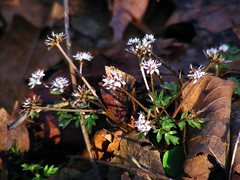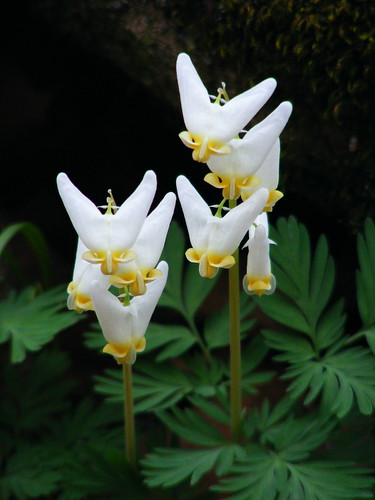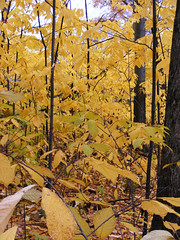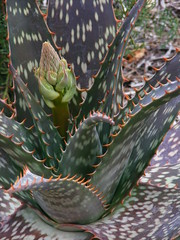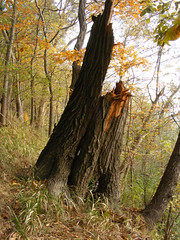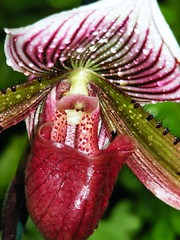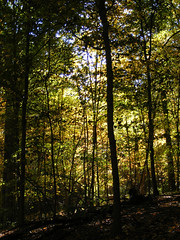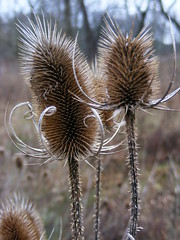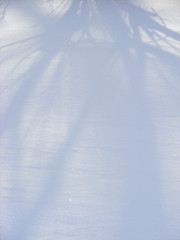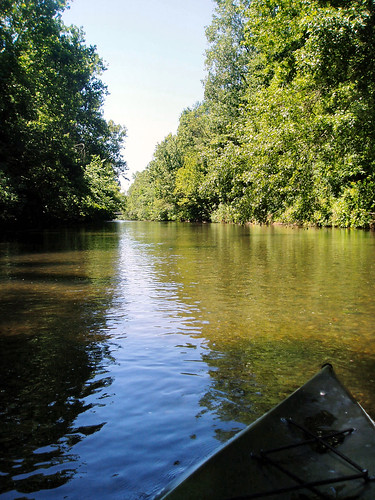Yeah, I have nothing to say today. Same as yesterday. So I'm going to let someone else do the blogging for me. Here's a video from the Sierra Club on backyard composting:
Tuesday, April 29, 2008
Sunday, April 27, 2008
Weekend Report
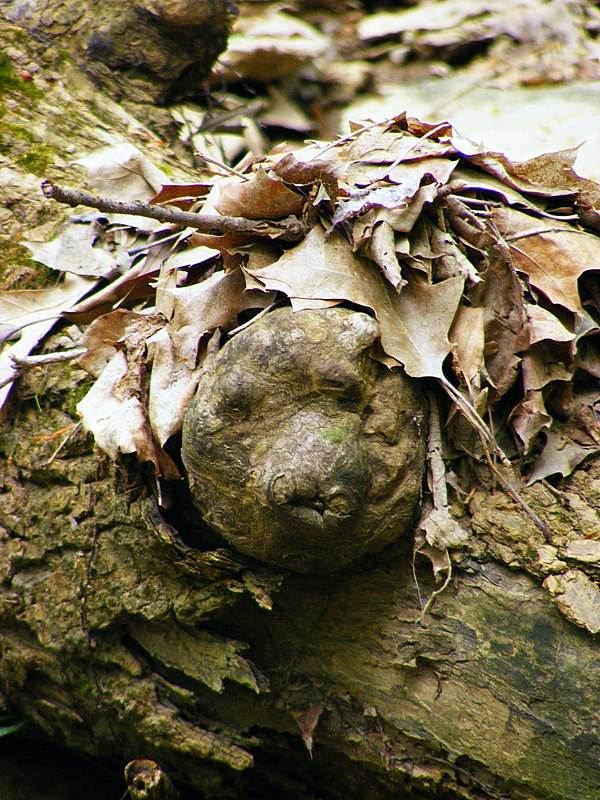 Saturday morning I got up bright and early and dashed down to Findlay Market to see what goodies were available. I found (and brought home) asparagus, spinach, sorrel, eggs and a pot of thyme, all locally grown. I also found fresh fava beans at Madison's so I grabbed some of those as well. I'm going to make sorrel soup from the recipe I found on the Cincinnati Locavore blog tomorrow night.
Saturday morning I got up bright and early and dashed down to Findlay Market to see what goodies were available. I found (and brought home) asparagus, spinach, sorrel, eggs and a pot of thyme, all locally grown. I also found fresh fava beans at Madison's so I grabbed some of those as well. I'm going to make sorrel soup from the recipe I found on the Cincinnati Locavore blog tomorrow night.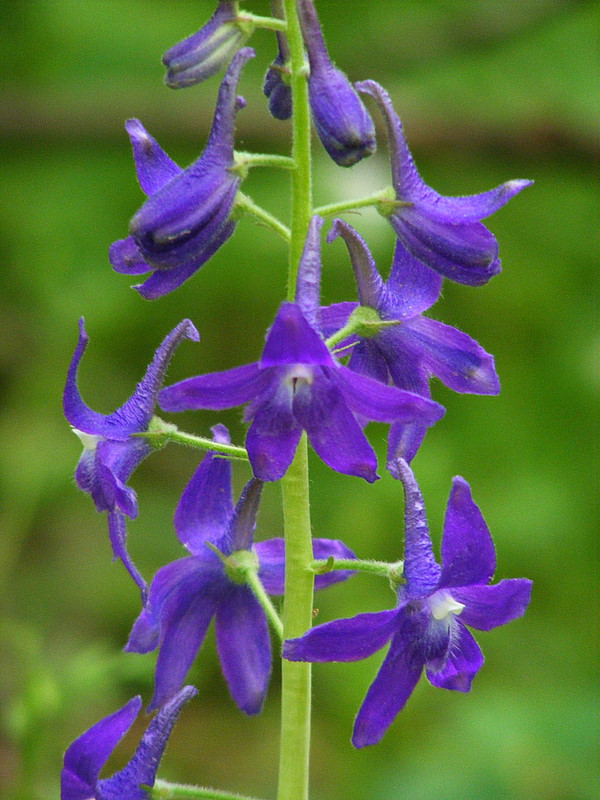
I'd planned to spend the rest of the weekend at home finishing my spring cleaning, but today was just too nice outside and I dropped everything this afternoon to get in a quick two and a half mile hike over at French Park. I'm glad I did; I heard reedy calls of Gnatcatchers several times and I also heard the first Red-Eyed Vireo and Hermit Thrush of the season. Larkspur and Blue-Eyed Mary were in bloom as well. Unfortunately, French Park seems to be a bit sparse on native wildflowers and heavy in the introduced and problematic Garlic Mustard; there was scads of it blooming on the hillsides. I guess deer don't care much for its flavor.
Saturday, April 26, 2008
Walking
I read a fascinating article in the New York Magazine last night about walking and how shoes are wrecking our ability to walk properly. It makes the case that our feet have been honed by four million years of evolution to carry us everywhere and that shoes, even the ones designed for maximum comfort, thwart the abilities of our foot to work properly. I'm not going to try to paraphrase the arguments here; read it for yourself and see if they don't make a good case for going barefoot.
But barefoot is hardly a choice for me, even when not working. Despite the fact that I walk an awful lot for pleasure, my bare soles are tender and I couldn't walk across more than a few feet of pavement without wincing and mincing, not to mention the dangers of encountering glass or dog poop. The article did suggest some footwear that is designed to allow the barefoot gait while offering some protection against our urban environments, but they tended to be ironically expensive for things trying to be so very natural.
That leaves me considering investing in moccasins. Proper ones, made of real, durable leather, not the little slippers designed only for indoor use. The New York Magazine article only mentioned moccasins in passing, but they're really the time-tested footwear for walking as close to barefoot as possible while adding protection for the foot. I found a place in Minnesota that will custom make moccasins using the outline of your foot as a template. Before I try that though I'm going to look around locally a little more and see if there isn't a moccasin-maker a bit closer to me so I could try them on first.
In the mean time, I am going to go and have a look at Vibram Five-Fingers for kayaking purposes. They look a bit silly, but also fun.
But barefoot is hardly a choice for me, even when not working. Despite the fact that I walk an awful lot for pleasure, my bare soles are tender and I couldn't walk across more than a few feet of pavement without wincing and mincing, not to mention the dangers of encountering glass or dog poop. The article did suggest some footwear that is designed to allow the barefoot gait while offering some protection against our urban environments, but they tended to be ironically expensive for things trying to be so very natural.
That leaves me considering investing in moccasins. Proper ones, made of real, durable leather, not the little slippers designed only for indoor use. The New York Magazine article only mentioned moccasins in passing, but they're really the time-tested footwear for walking as close to barefoot as possible while adding protection for the foot. I found a place in Minnesota that will custom make moccasins using the outline of your foot as a template. Before I try that though I'm going to look around locally a little more and see if there isn't a moccasin-maker a bit closer to me so I could try them on first.
In the mean time, I am going to go and have a look at Vibram Five-Fingers for kayaking purposes. They look a bit silly, but also fun.
Labels:
barefoot,
evolution,
footwear,
in the news,
life as I know it,
shoes,
walking
Friday, April 25, 2008
European Wall Lizards
I read an interesting article in National Geographic News about European Wall Lizards this week. A few pairs were released on a tiny island in the Adriatic Sea in the early 1970s. They reproduced unchecked and unobserved for the next thirty years and when scientists were able to return to the island (hindered previously by war) they found some astonishing changes in the lizards. Not only had the lizards changed in behavior, but their heads had become larger and they'd evolved a new structure in their intestines which allowed them to make the change from an insect-based to a plant-based diet. It's a truly astonishing rate of evolutionary change.
The article initially caught my eye because Cincinnati has been home to an introduced population of European Wall Lizards since 1951, when a handful of lizards were released by a member of the Lazarus family, they of department store fame. In fact, the lizards are sometimes known locally as "Lazarus Lizards". I've encountered them often around town; they especially seem to love Mount Adams and other areas with lots of stone walls.
The article initially caught my eye because Cincinnati has been home to an introduced population of European Wall Lizards since 1951, when a handful of lizards were released by a member of the Lazarus family, they of department store fame. In fact, the lizards are sometimes known locally as "Lazarus Lizards". I've encountered them often around town; they especially seem to love Mount Adams and other areas with lots of stone walls.
Labels:
biology,
evolution,
in the news,
interesting,
lizards,
nature,
reptiles
Tuesday, April 22, 2008
Ramp Report
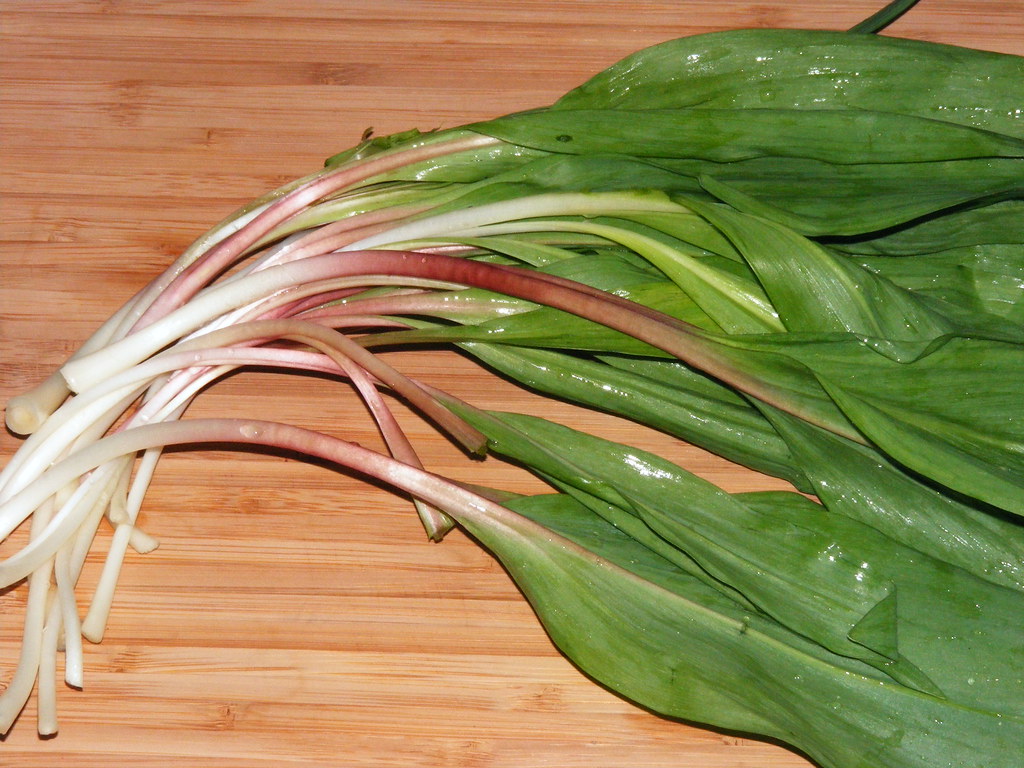 I cooked the ramps I purchased at Madison's at Findlay Market for Sunday breakfast. I cleaned the ramps by snipping off the roots, rinsing them well in cold water and cutting them into two-inch sections, green leaves and all. I sautéed a couple of pieces of bacon until they were nice and crisp, then set them aside. Then I cooked the ramps in the bacon fat until they were tender, which took about seven minutes. I seasoned them with black pepper and crumbled the bacon into them, then served alongside scrambled eggs. The taste was somewhat like that of a garlicky green onion. They were delicious, but probably not eighteen dollars a pound delicious. I don't think I'll be buying them again unless it's at a proper ramp festival in the mountains, but I'd happily forage for them if I'm ever lucky enough to find them growing in the woods.
I cooked the ramps I purchased at Madison's at Findlay Market for Sunday breakfast. I cleaned the ramps by snipping off the roots, rinsing them well in cold water and cutting them into two-inch sections, green leaves and all. I sautéed a couple of pieces of bacon until they were nice and crisp, then set them aside. Then I cooked the ramps in the bacon fat until they were tender, which took about seven minutes. I seasoned them with black pepper and crumbled the bacon into them, then served alongside scrambled eggs. The taste was somewhat like that of a garlicky green onion. They were delicious, but probably not eighteen dollars a pound delicious. I don't think I'll be buying them again unless it's at a proper ramp festival in the mountains, but I'd happily forage for them if I'm ever lucky enough to find them growing in the woods.
Labels:
"Findlay Market",
breakfast,
Cincinnati,
cooking,
food,
life as I know it,
Ohio,
produce,
ramps,
vegetables
Monday, April 21, 2008
Waste less food, save more energy
I picked up this great tip from Planet Green today! I'm using the whiteboards to keep track of the fresh produce in my fridge, as well as a freezer inventory. I'm guilty of buying produce and forgetting about it until it's become inedible. This will also cut back on opening the fridge or freezer door (and letting all the cold air pour out) and staring at the contents while trying to decide what to make for dinner.
The whiteboards were a heck of a lot cheaper than buying a glass-doored refrigerator.
The whiteboards were a heck of a lot cheaper than buying a glass-doored refrigerator.
Saturday, April 19, 2008
Around town
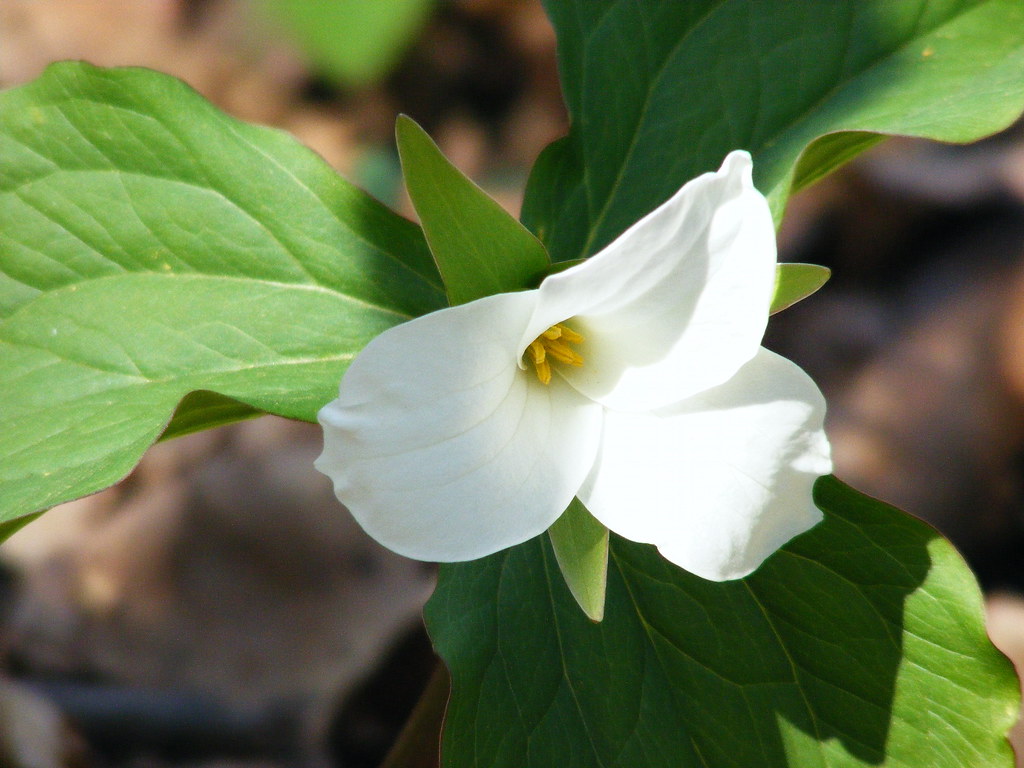 I found trillium blooming for the first time this spring during my quick walk around the Caldwell Nature Preserve yesterday after work. Digital cameras are terrible at photographing white objects; the nuances tend to get lost. Trying to photograph a white flower is difficult for this reason and I was crawling (carefully, so as not to smush other wildflowers) all over the hillside trying to find a trillium in just the right amount of shade. I think I'll start carrying a sheet of paper with me for creating my own dappled sunlight in the future.
I found trillium blooming for the first time this spring during my quick walk around the Caldwell Nature Preserve yesterday after work. Digital cameras are terrible at photographing white objects; the nuances tend to get lost. Trying to photograph a white flower is difficult for this reason and I was crawling (carefully, so as not to smush other wildflowers) all over the hillside trying to find a trillium in just the right amount of shade. I think I'll start carrying a sheet of paper with me for creating my own dappled sunlight in the future.Early this morning I went down to Findlay Market and blew my grocery budget for the week. I brought home a few things I've not cooked with before, including rhubarb, ramps ($18 a pound!) and the spice Grains of Paradise. The afternoon was spent in the company of friends down at the Earth Day celebration at Sawyer Point. Somehow the rain held off and we managed to score a few good freebies, including CFL light bulbs. Here's a tiny handful of useful links I picked up today:
- Get a bin, find out what items can be recyled and find information on hazardous household waste drop-offs - Hamilton County Department of Environmental Services
- Soil fertility testing kits are available for a nominal fee from the Hamilton County Soil & Water Conservation District
- The Ohio River Sweep will be held this year on Saturday, June 21st
- Enright Ridge is an Urban Eco-Village is a community fostering a sustainable urban neighborhood, located on the west side of Cincinnati
- Although I didn't see them at the Sawyer Point Earth Day celebration I'm posting a link to Little Miami, Inc. - dedicated to preserving my favorite local river
Labels:
Cincinnati,
Earth Day 2008,
flora,
flowers,
hiking,
kayaking,
life as I know it,
Little Miami River,
nature,
Ohio,
recyling
Friday, April 18, 2008
Earthquake in Cincinnati!
 I was just awakened (about 5:40 AM) by the windows of my bedroom rattling and my bed rocking back and forth. The shaking lasted about ten seconds. The morning news is reporting other people feeling earth tremors in the area. I've never felt an earthquake before!
I was just awakened (about 5:40 AM) by the windows of my bedroom rattling and my bed rocking back and forth. The shaking lasted about ten seconds. The morning news is reporting other people feeling earth tremors in the area. I've never felt an earthquake before!According to the USGS it was a 5.4 degree quake centered in southern Illinois.
From WCPO: 5.4 Earthquake Rocks Illinois, Rattles Tri-State. We even made the world news; here's a report from the BBC.
Labels:
Cincinnati,
earthquake,
in the news,
life as I know it,
Ohio
Thursday, April 17, 2008
Juniper Berries
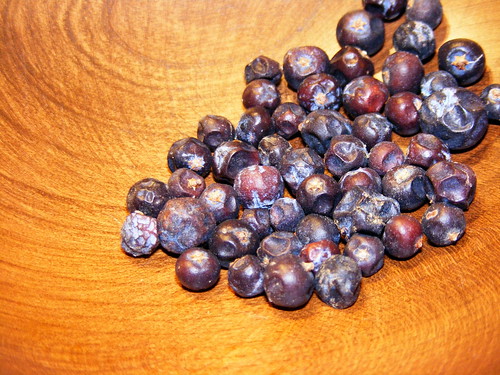 I decided to cook the lamb shanks I've had in the freezer for a while now and I found a nice recipe for Greek lamb braised in red wine. The recipe called for juniper berries and I did manage to find some - at more than five dollars for a little jar! I purchased them anyway so I'll have to find some other uses for them. According to Chowhound.com they have an affinity for the following foods: allspice, apple, bacon, black pepper, boar, duck, goose, marjoram, onion, pâté, pork, sage, shallot, red wine, thyme, venison, vermouth.
I decided to cook the lamb shanks I've had in the freezer for a while now and I found a nice recipe for Greek lamb braised in red wine. The recipe called for juniper berries and I did manage to find some - at more than five dollars for a little jar! I purchased them anyway so I'll have to find some other uses for them. According to Chowhound.com they have an affinity for the following foods: allspice, apple, bacon, black pepper, boar, duck, goose, marjoram, onion, pâté, pork, sage, shallot, red wine, thyme, venison, vermouth.The juniper is an evergreen tree native to Europe and North America and it produces small bluish berries (actually a tiny, densely packed cone) which take three years to mature. Juniper berries have been used since the times of the ancient Romans, Greeks and Egyptians. Pliny mentioned that they were used in place of expensive imported black pepper and juniper berries were found in the tomb of Tutankhamun.
Juniper berries are probably best known today for giving the liquor gin its characteristic flavor. The word "gin" is a corruption of genièvre, the French word for juniper.
Celtic lore tells us the juniper grown by the door will discourage thieves (probably because it's a prickly plant), while hanging strings of dried juniper berries will attract love.
Labels:
cooking,
food,
juniper,
life as I know it,
spices
Wednesday, April 16, 2008
The Return of the Cicada
 WCPO reported today that Cincinnati is due to see a return of the periodic cicada this summer. I was in town for the 1991 and the 2004 emergence and those were spectacular. This year's brood is more to the east of the city than those previous emergences so I'll probably have to take a drive to see it in all its glory.
WCPO reported today that Cincinnati is due to see a return of the periodic cicada this summer. I was in town for the 1991 and the 2004 emergence and those were spectacular. This year's brood is more to the east of the city than those previous emergences so I'll probably have to take a drive to see it in all its glory.Photo by tlindenbaum by way of Flickr.
Labels:
cicadas,
Cincinnati,
in the news,
nature,
Ohio
Tuesday, April 15, 2008
Labyrinthitis
I went to the doctor today to find out why I was still feeling ill and she diagnosed me with labyrinthitis. I'd pretty much figured that out from the symptom checker on WebMD but I wanted to make sure it wasn't caused by a bacterial infection. Labyrinthitis (that's such a cool name) is just an inflammation of the inner ear and is the cause of the symptoms I've been experiencing: sensitivity to sound, roaring in the ears and some slight vertigo. Unfortunately there is no cure but time and I'm just going to have to endure this muzzy-headed feeling until it works its way out of my system. In the immortal words of Charlie Brown, "bleah".
Monday, April 14, 2008
Earth Day in Cincinnati, 2008
 Earth Day is Tuesday April 22nd. Here are some links to events and celebrations in the Cincinnati area.
Earth Day is Tuesday April 22nd. Here are some links to events and celebrations in the Cincinnati area.Earth Day at Sawyer Point is the big event held April 19th from noon until 7 PM. There will be music, contests, an awards ceremony and much more.
Glenwood Gardens Highfield Discovery Garden has programs this week to celebrate Earth Day. Learn how to beautify your world by planting flowers, learn how to reduce your impact on the earth by reducing, reusing and recycling everyday products. Programs are Tuesday (April 22nd) through Saturday (April 26th) at 10:45 am, 1 pm and 4 pm; Sunday (April 27th) at 1 pm and 4 pm.
Blue Ash Nature Park (4433 Cooper Road, Blue Ash, OH 45242 513-745-8550) is hosting an Earth Day event on Friday, April 25, 2008 from 4 PM to 7 PM. This special event will include Toyota, Rumpke, Veg Head, Gorman Heritage Farm, demonstrations, free samples, family activities and more.
This Land is Your Land Earth Day Celebration Thursday, April 18 11:00 AM - 1:00 PM Fountain Square
To celebrate Earth Day 2008, Cincinnati Computer Cooperative (C3) will participate in the Recycling Collection event being held on Saturday April 19 at the Miami Township Service Department, 5900 McPicken Drive, in Clermont County from 9:00 AM to 12:00 PM, and an E-Cycling event on Saturday April 26 from 9:00 AM to 12:00 PM at its facility, 49 Novner Drive, Cincinnati, Ohio (Woodlawn) Phone 513-771-3262.
More links to events world-wide can be found at Earthday Network.
Labels:
biology,
Cincinnati,
conservation,
Earth Day 2008,
ecology,
in the news,
nature
Sunday, April 13, 2008
Late to the party
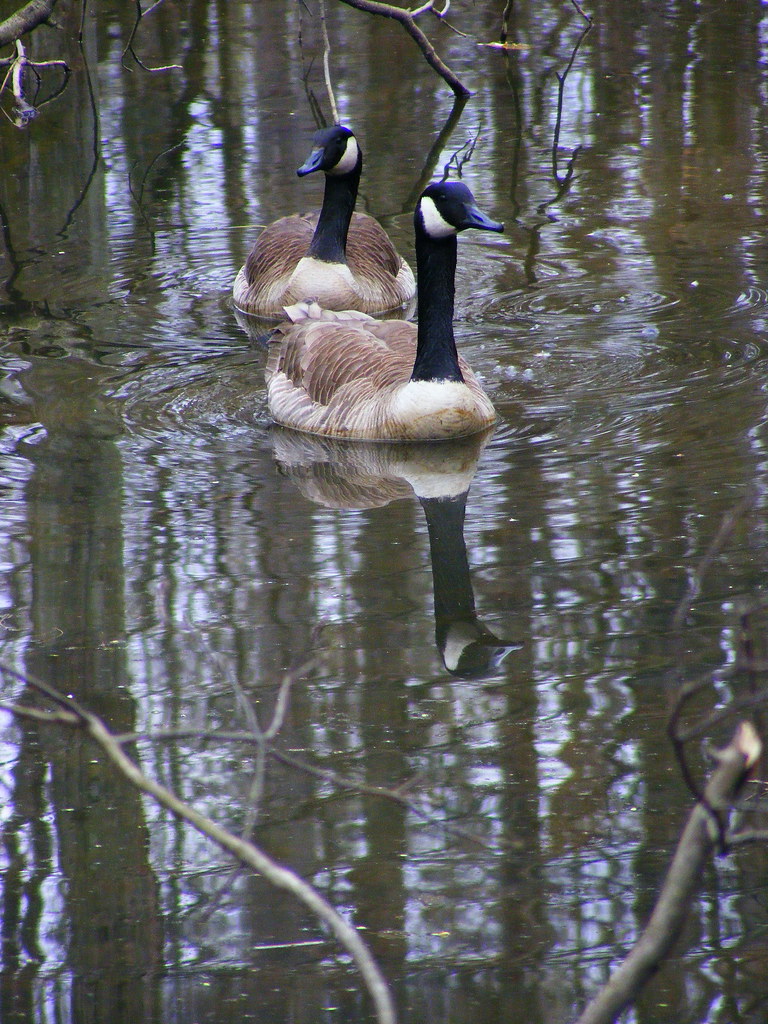 Well, I missed out on the fact that the American Ornithologist's Union had split the Canada Goose subspecies into two distinct species back in 2004. I knew the Canada Goose (pictured) had several subspecies before, mostly varying in size (smaller to the north) and coloration (darker to the west). Results from genetic analysis revealed that four of the smallest subspecies of the Canada Goose were quite distinct from the larger subspecies and the A.O.U. decided they were sufficiently different to be known as a separate species called the Cackling Goose.
Well, I missed out on the fact that the American Ornithologist's Union had split the Canada Goose subspecies into two distinct species back in 2004. I knew the Canada Goose (pictured) had several subspecies before, mostly varying in size (smaller to the north) and coloration (darker to the west). Results from genetic analysis revealed that four of the smallest subspecies of the Canada Goose were quite distinct from the larger subspecies and the A.O.U. decided they were sufficiently different to be known as a separate species called the Cackling Goose.The conundrum this poses for birders is well illustrated in the article The New Goose. I've no idea if I've seen this bird or not; I certainly saw tiny Canada Geese during visits to California in the past but I didn't give them much thought. On my next visit I'll be paying more attention.
Labels:
"Cincinnati Nature Center",
birding,
birds,
Cackling Goose,
Canada Goose,
geese,
goose,
indentification,
nature,
waterfowl
Saturday, April 12, 2008
Bloodroot
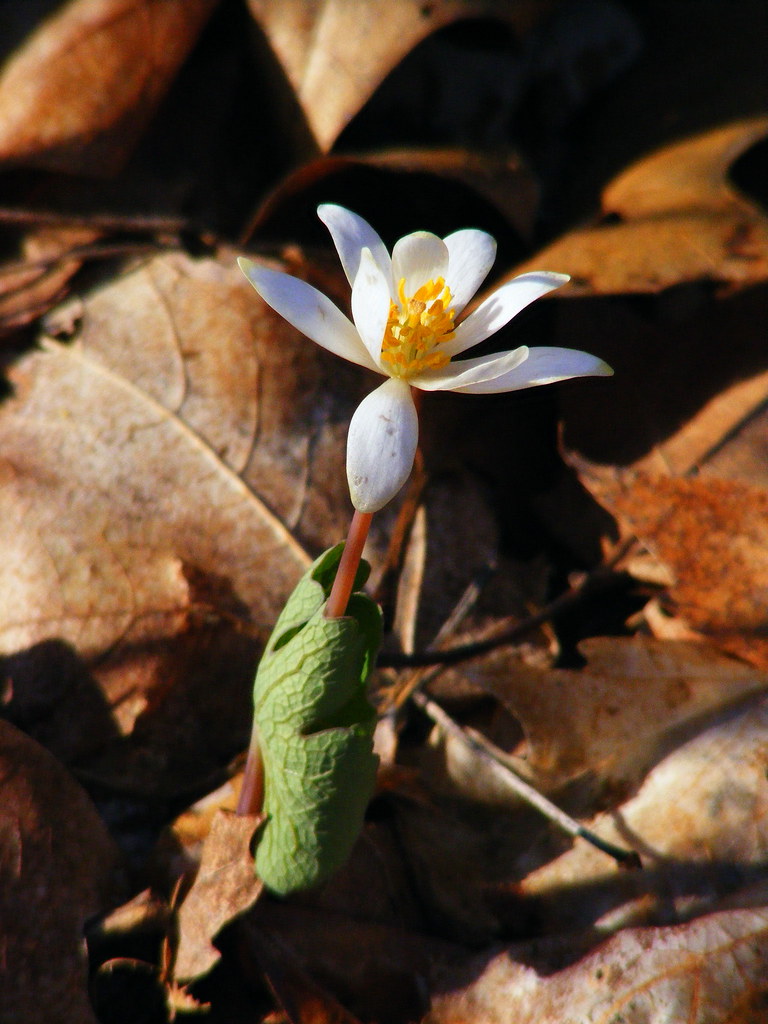 Bloodroot (Sanguinaria canadensis) is blooming in our area now, but I've been thwarted in my efforts to get a decent photo this year. I have one good picture of the blossom and another of the leaf, but not both at the same time.
Bloodroot (Sanguinaria canadensis) is blooming in our area now, but I've been thwarted in my efforts to get a decent photo this year. I have one good picture of the blossom and another of the leaf, but not both at the same time.Bloodroot is so named because when the root is damaged it emits a blood red juice. This liquid was used by Native Americans as a dye for baskets and clothing and for painting their faces and bodies.
 Although, or perhaps because, the plant has toxic properties it has long been used as a medication. Bloodroot is known to contain an escharotic, a substance that kills tissue, and the juice has been used in preparations to kill ringworm, fungal growths and warts. It is also used in mouthwashes to kill gingivitis and plaque. Despite its useful properties, self-medication is an exceedingly bad idea due to the plant's poisonous substances. It's far too lovely a plant to destroy in any case.
Although, or perhaps because, the plant has toxic properties it has long been used as a medication. Bloodroot is known to contain an escharotic, a substance that kills tissue, and the juice has been used in preparations to kill ringworm, fungal growths and warts. It is also used in mouthwashes to kill gingivitis and plaque. Despite its useful properties, self-medication is an exceedingly bad idea due to the plant's poisonous substances. It's far too lovely a plant to destroy in any case.
Labels:
"Cincinnati Nature Center",
Bloodroot,
flora,
hiking,
interesting,
nature,
wildflowers
Thursday, April 10, 2008
The Evil Virus, how to construct a lodge and making homemade cheese
Since late Sunday night I've been battling an odd virus. My head feels like it's packed with cotton wool, I'm tired, listless, weak and my muscles ache. On the plus side, this particular virus doesn't come with sneezing, sore throat or coughing, but it leaves me with no symptoms that might elicit sympathy either. It has been a most trying week at work to boot and I've spent my evenings on the couch under a comforter, remote in hand.
 I was flipping through the channels tonight when I came across a naturalist talking about how beaver lodges are constructed. I had always assumed that during construction the beavers left a hollow space within the pile of branches and mud that comprises the building material of the lodge. As it turns out they first build the dense mound of material, then working from below, use their claws and teeth to dig and chew the underwater entrance and the burrow.
I was flipping through the channels tonight when I came across a naturalist talking about how beaver lodges are constructed. I had always assumed that during construction the beavers left a hollow space within the pile of branches and mud that comprises the building material of the lodge. As it turns out they first build the dense mound of material, then working from below, use their claws and teeth to dig and chew the underwater entrance and the burrow.
I also came across instructions on how to make mozzarella cheese at home, which I may try once I'm healthy again. It looks like a good choice for a home cheese making experiment since it doesn't have to be aged. Although perhaps starting with something simpler might not be a bad plan - home made cottage cheese is supposed to be very good.
 I was flipping through the channels tonight when I came across a naturalist talking about how beaver lodges are constructed. I had always assumed that during construction the beavers left a hollow space within the pile of branches and mud that comprises the building material of the lodge. As it turns out they first build the dense mound of material, then working from below, use their claws and teeth to dig and chew the underwater entrance and the burrow.
I was flipping through the channels tonight when I came across a naturalist talking about how beaver lodges are constructed. I had always assumed that during construction the beavers left a hollow space within the pile of branches and mud that comprises the building material of the lodge. As it turns out they first build the dense mound of material, then working from below, use their claws and teeth to dig and chew the underwater entrance and the burrow.I also came across instructions on how to make mozzarella cheese at home, which I may try once I'm healthy again. It looks like a good choice for a home cheese making experiment since it doesn't have to be aged. Although perhaps starting with something simpler might not be a bad plan - home made cottage cheese is supposed to be very good.
Labels:
animals,
cheese,
diy,
food,
interesting,
life as I know it,
nature,
preperation
Wednesday, April 09, 2008
Seahorses in London
 Little seahorses have been found in the Thames river in England as far upstream as London, according to this article in National Geographic. The Thames is an ecological recovery success story. Subjected to decades of pollution, the Thames was declared biologically dead in the 1950s. Serious efforts to clean up the river began about twenty years ago and have had marvelous results. The river is the cleanest it's been since pre-industrial times and a number of extirpated species are reclaiming their old stomping grounds. In addition to the seahorses, brown trout, Atlantic salmon, dolphins, seals and one lost whale have been spotted in the Thames in recent years.
Little seahorses have been found in the Thames river in England as far upstream as London, according to this article in National Geographic. The Thames is an ecological recovery success story. Subjected to decades of pollution, the Thames was declared biologically dead in the 1950s. Serious efforts to clean up the river began about twenty years ago and have had marvelous results. The river is the cleanest it's been since pre-industrial times and a number of extirpated species are reclaiming their old stomping grounds. In addition to the seahorses, brown trout, Atlantic salmon, dolphins, seals and one lost whale have been spotted in the Thames in recent years.
Monday, April 07, 2008
Mondays...
I think I'll just start making Mondays my day to let someone else do the blogging. It's usually my busiest day at work and between that and the shock of going back to work after a nice weekend, my brain moves into auto-pilot. I get things done, but there's no contemplation going on.
I did walk the long path around Glenwood Gardens after work today and spotted about a half dozen Blue Winged Teal in one of the small ponds on their grounds. I'm always happy to see those pretty little ducks.
I leave you with a video on how to make a brimmed beanie out of an old sweater.
I did walk the long path around Glenwood Gardens after work today and spotted about a half dozen Blue Winged Teal in one of the small ponds on their grounds. I'm always happy to see those pretty little ducks.
I leave you with a video on how to make a brimmed beanie out of an old sweater.
Sunday, April 06, 2008
Go Local, Go Organic
As if I needed any more reasons to buy as much of my food as possible locally and/or organically produced, an article in the New York Times reports that pesticides used on food crops overseas are killing songbirds and raptors.
Did Your Shopping List Kill a Songbird?
Did Your Shopping List Kill a Songbird?
Spring Ephemerals
I finally ponied up the money and purchased a membership to the Cincinnati Nature Center. It's one of my favorite places to hike in the area and today I squelched my way across the two and a half mile Redwing Trail. I found lots of Harbinger-of-Spring (pictured) and Trout Lilies blooming in the woods, though it's still a week or so too early for other spring ephemeral wildflowers. Trillium, Dutchman's Breeches, Bloodroot and several others were above ground but still in bud today. We are expecting a warm week so next weekend should be peak time to take in these fleeting blossoms.
The morning started off chilly but quickly warmed as the sun rose higher into the sky. I happened to be hiking along a stream bed surrounded by a meadow when the temperature passed a certain threshold and suddenly the air was filled with the calls of Spring Peepers. That is the sort of thing that makes getting up before dark on a Sunday morning and heading out into the woods completely worthwhile.
The morning started off chilly but quickly warmed as the sun rose higher into the sky. I happened to be hiking along a stream bed surrounded by a meadow when the temperature passed a certain threshold and suddenly the air was filled with the calls of Spring Peepers. That is the sort of thing that makes getting up before dark on a Sunday morning and heading out into the woods completely worthwhile.
Labels:
"Cincinnati Nature Center",
"Spring Peepers",
ephemerals,
flowers,
frogs,
hiking,
nature,
spring,
wildflowers
Saturday, April 05, 2008
Posole and Hominy
 My mind has been on Mexican and Tex-Mex food since I returned from San Antonio. I came across a can of white hominy in the cupboard and so decided to try my hand at making posole for the first time. Posole is a stew, generally made from pork, hominy and chilies, served all across Mexico and the American Southwest. The first thing I discovered while searching for a recipe is that there are thousands of them. I chose a simple, reputably authentic recipe from Urban Farm Girl mostly because there were few ingredients and I had all of them on hand. I used an ancho chile along with the red chilies and I had to substitute dried, granulated garlic for fresh (I am unaccountably out of garlic and didn't want to run to the store for just that); otherwise I followed the recipe and it was delicious. I made it in my seldom-used cast iron dutch oven; I'm thinking this would be a good dish to make over a campfire.
My mind has been on Mexican and Tex-Mex food since I returned from San Antonio. I came across a can of white hominy in the cupboard and so decided to try my hand at making posole for the first time. Posole is a stew, generally made from pork, hominy and chilies, served all across Mexico and the American Southwest. The first thing I discovered while searching for a recipe is that there are thousands of them. I chose a simple, reputably authentic recipe from Urban Farm Girl mostly because there were few ingredients and I had all of them on hand. I used an ancho chile along with the red chilies and I had to substitute dried, granulated garlic for fresh (I am unaccountably out of garlic and didn't want to run to the store for just that); otherwise I followed the recipe and it was delicious. I made it in my seldom-used cast iron dutch oven; I'm thinking this would be a good dish to make over a campfire.Not only was it the first time I tried posole, but it was the first time I ever had hominy either. What can I say, I haven't spent much time in the American South. I really liked it and I'm sorry I missed out on it all these years. The texture surprised me somewhat. It kept its integrity throughout a rather lengthy cooking process - almost more like a bean; fresh sweet corn wouldn't have held up nearly so well after cooking for two hours in a dutch oven.
Hominy is dried maize which has been treated with an alkali to remove its tough outer hull, through a process known as nixtamalization. Nixtamalization has been practiced since at least 1200 BC, the earliest archaeological evidence having been found in Guatemala. The process is crucial to not only removing the tough outer hull, but to unlocking the nutrients within the large, starchy grain. Alton Brown's episode of Good Eats - Tort(illa) Reform talked about this process in some detail and a portion of the transcript follows:
Transcript courtesy of Good Eats Fan Page
Once upon a time in 1519, a certain Spanish businessman/adventurer named Hernando Cortez landed in what is today Veracruz, Mexico. Why? Because he had a serious hankering for gold, which he soon found heaps of in the Aztec city-state of Tenochtitlán, which was, at the time, probably the most splendid city on earth.
Figuring he would be a far better steward of all that wealth, Cortez aided by cannons, horses, smallpox, and a legend that made him out to be a returning god, captured the city's ruler, Montezuma, and set about decimating one of the greatest civilizations our planet has ever hosted. Had Cortez stopped just for a moment to consider how it was that such heathen savages were able to erect such a bling-encrusted metropolis, he might have discovered a very different kind of gold altogether ...
SCENE 4
The Kitchen
GUEST: Deb Duchon, Nutritional Anthropologist
AB: ... maize. You know, the average Meso-American diet was very corny indeed. But unlike the sweet field corn we modern North American Anglos know and love, the stuff the Aztec lived on was very very starchy and came with a very thick outer hull, or pericarp, okay? Now, probably 10,000 years or so before Columbus showed up, these early Americans learned that if they...
DD: ... if they soaked and cooked the maize in water with wood ashes in it, that the hulls would just slip right off.
AB: You notice how I don't even have to think "nutritional anthropologist" anymore, and she shows up?
AB: Okay, I'll bite. What's with the wood ashes?
DD: They're alkaline, of course.
AB: Ah. Well, that certainly explains why, last summer, when I left all those ashes in my grill, and it rained a bunch, the bottom of the grill corroded out.
DD: I remember that. But today's Mexican cooks don't use wood ashes anymore. They use cal.
AB: Oh, short for calcium hydroxide, a.k.a. slaked lime. It's used in the construction business to help concrete harden.
DD: But the really fascinating thing about it was that the Meso-Americans thought they were just removing the pericarp, but what they were actually doing was setting in motion this miraculous and amazing phenomenon.
AB: I sure hope you're not about to launch into one of your long soliloquies without the benefit of a visual aid.
DD: Well, check this out then.
AB: Okay.
DD: The miracle of nixtamal... [DD clicks a remote and a large cage descends]
AB: Whoa. Wow, what a sweet visual metaphor representing the many nutrients locked away inside a kernel of corn. Hah, think I'll have a little proline. Hey, what gives? I can't get any of them out.
DD: Nixtamalization is like a chemical key that unlocks all the wonderful nutrients that are locked inside a kernel of maize.
AB: So what kind of nutrients are we talking about here?
DD: Well, for one thing, amino acids like lysine and tryptophan. But most importantly, vitamin B3 better known as niacin. Now if the Aztecs hadn't had nixtamalization, they wouldn't even have the energy to build that magnificent empire of theirs. And once Cortez showed up, he probably wouldn't even have paid much attention to them. He certainly had no reason to destroy their empire like he did.
AB: Got it.
DD: But in a way, they got their revenge, because when Cortez and the other conquistadores brought maize back to the Old World, they didn't take nixtamalization.
AB: Yeah.
DD: So the countries and peoples that adopted corn as their main grain soon suffered from a terrible disease of malnutrition called pellagra.
AB: What's pellagra do?
DD: The three dreaded Ds: diarrhea, dementia, and death.
AB: Well, I guess that's Montezuma's real revenge.
Labels:
Alton Brown,
cooking,
corn,
food,
history,
hominy,
nutrional anthropology,
pork,
recipes
Friday, April 04, 2008
Mike Fink
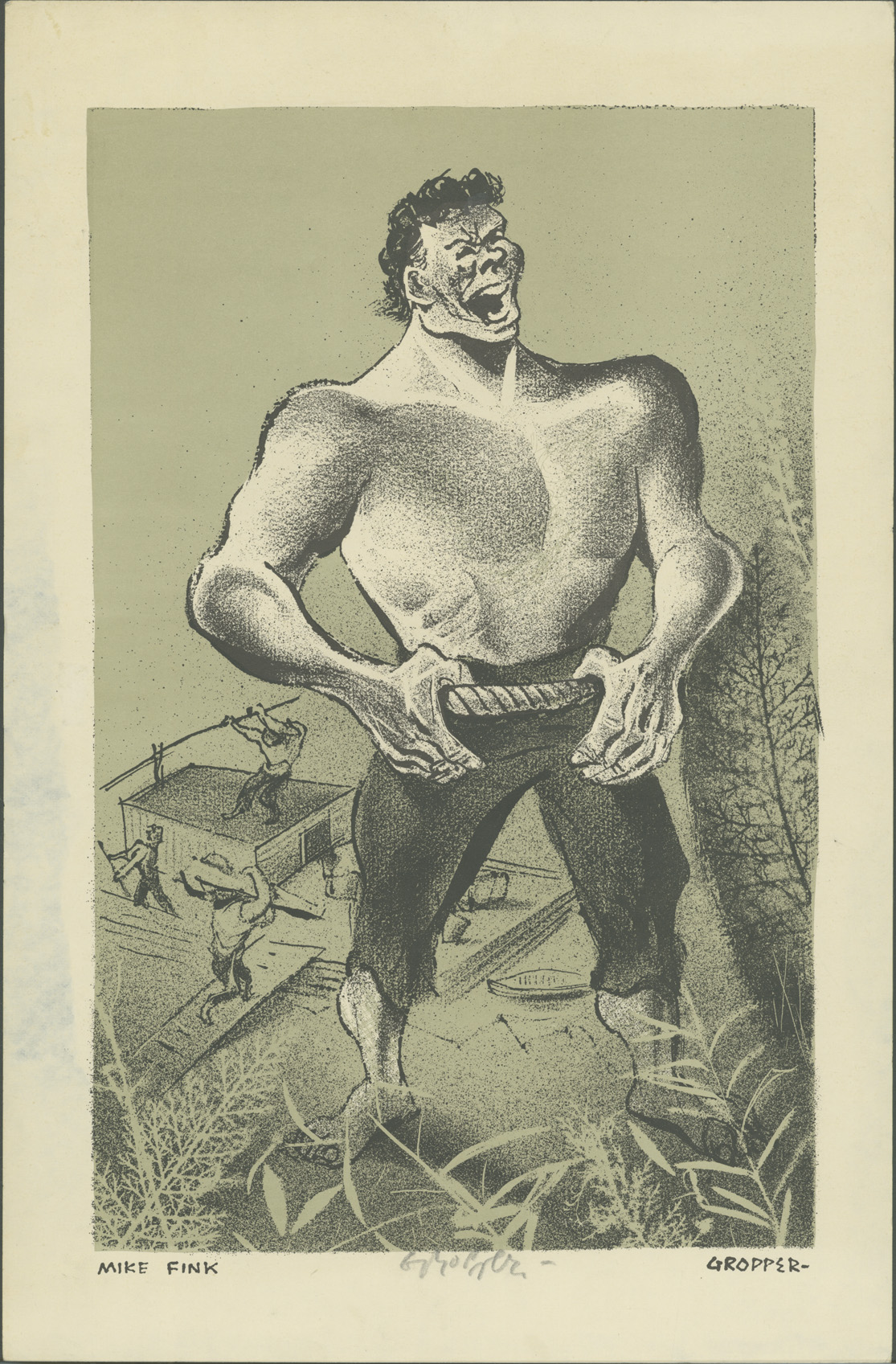 I'm not sure how I managed to live in a river city for forty some years without hearing or reading stories about Mike Fink. I knew of the riverboat by that name of course; I've even had a couple of meals there. But I never gave a second thought as to who Mike Fink was until I came across the name in a history of the Alamo yesterday.
I'm not sure how I managed to live in a river city for forty some years without hearing or reading stories about Mike Fink. I knew of the riverboat by that name of course; I've even had a couple of meals there. But I never gave a second thought as to who Mike Fink was until I came across the name in a history of the Alamo yesterday.Mike Fink was the known as "The Last of the Boatmen", one of those men who made their living navigating the large rivers of the American interior before the days of steam powered paddle-wheelers. He was a semi-legendary figure, born in the late 1700s in Pittsburgh, Pennsylvania to French-Canadian parents. The reason his name appeared in the Alamo history I read was because he was supposed to have crossed paths with Davey Crockett, who described Fink as "half horse and half alligator." All accounts describe his being a keen shot with a rifle, hard-drinking, popular with the ladies and possessing both a quick wit and a bad temper. For further edification, click the link below.
Labels:
boatmen,
Cincinnati,
history,
keelboats,
Mike Fink,
Mississippi,
Missouri,
Ohio,
River,
rivers
Thursday, April 03, 2008
Grocery Project
 I completed the first half of my grocery project on Monday. I photographed all the groceries I purchased during the month of March. I'm also going to photograph the groceries I buy in July, because that's when the farmer's market will be in full swing.
I completed the first half of my grocery project on Monday. I photographed all the groceries I purchased during the month of March. I'm also going to photograph the groceries I buy in July, because that's when the farmer's market will be in full swing.March is a little skewed because I was on vacation for almost a week and every meal while away was eaten in a restaurant. I didn't bother to include those meals in my total since when I'm not on vacation I only eat out once or twice a month at best. I spent a total of $230 on groceries for the month and I think that's somewhat under my average monthly bill, which I figure to be around $300.
This project was inspired by looking at these photos and I simply was curious to see how my purchases compared. I think my spending is on par with the average American's spending. I'm not a terribly frugal shopper when it comes to groceries though. I tend to buy what I want without worrying about price, I try to buy quality stuff and I don't use coupons. This is probably balanced out by not buying many "convenience" foods, which are often more expensive and less nutritious than whole foods.
So if you find yourself terribly bored, you can have a gander at what my groceries look like for one month. If you've done a similar project, I'd love to see it too!
Labels:
cooking,
food,
groceries,
interesting,
life as I know it,
projects,
vegetables
Wednesday, April 02, 2008
Restaurants, San Antonio
 This is my last post about San Antonio, honest. Mostly I wanted to note the better restaurants I went to for future reference; I am planning a return trip.
This is my last post about San Antonio, honest. Mostly I wanted to note the better restaurants I went to for future reference; I am planning a return trip.Most of the food on the Riverwalk is mediocre at best, but happily there is one exception - Acenar. The guacamole made tableside by Ricardo was fabulous. For my entrée I had the Gulf Fish Tacos and my sister had Conchita Pibil and I thought they were both wonderful.
The Blanco Cafe at 419 N. St. Mary's Street was voted the best breakfast tacos in town by the locals. I think the most expensive taco on the menu was $1.89 and one taco was enough to keep me going until lunch. I had the potato and chorizo one morning and egg and beans the next. They were both great; I've been craving them ever since.
I had dinner on my own at Azuca, where I tried a Caipirinha (the national drink of Brazil) for the first time. The sugar and lime didn't disguise the fact the the cachaça, a sugarcane liquor, has some serious claws. I opted for a "light" dinner of a cup of black bean soup and the appetizer of Amazonian Tamal; both were delicious and I couldn't finish everything. I was served a mini-loaf of hot cornbread along side my meal which ended up being my breakfast the next day.
I already mentioned Harmon's Barbecue in my previous post, but I neglected to say that it was the only place I've ever been that has self-serve beer. Seriously. You pay for your beer at the counter and there is an ice bin in the middle of the floor filled with bottles of beer and you help yourself. Amazing.
For lunch one day I ordered a salad at a nameless Riverwalk restaurant just because it came with nopalitas, or cactus paddles. I'd never tried them before and I was curious. I remain curious, because they came pickled and really only tasted like a mushy pickled vegetable. They do show up fresh in the markets around here from time to time; I'll bring some home next time I see them and figure out how to cook them.
Labels:
"San Antonio",
beer,
cactus,
food,
nopalitas,
restaurants,
Texas
Tuesday, April 01, 2008
A great place to bird...
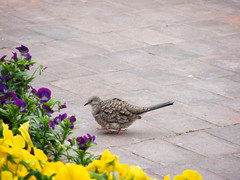 Texas is a great place to bird. Most of the migratory bird species that nest in North America will pass through Texas at some point. I visited the San Antonio Botanical Garden my second day in town and the birds appeared to be as thrilled with it as I was. It's a gorgeous park, sprawling over 33 acres, it includes several greenhouses featuring different collections as well as trails which pass through representations of three of the typical habitats of Texas: South Texas, Piney Woods and Hill Country. Before I knew it three hours had passed and I was a bit tired and hungry. Fortunately for me the Garden has a nice cafe where I was able to revive with a bowl of lamb caldo and some tea.
Texas is a great place to bird. Most of the migratory bird species that nest in North America will pass through Texas at some point. I visited the San Antonio Botanical Garden my second day in town and the birds appeared to be as thrilled with it as I was. It's a gorgeous park, sprawling over 33 acres, it includes several greenhouses featuring different collections as well as trails which pass through representations of three of the typical habitats of Texas: South Texas, Piney Woods and Hill Country. Before I knew it three hours had passed and I was a bit tired and hungry. Fortunately for me the Garden has a nice cafe where I was able to revive with a bowl of lamb caldo and some tea.On Saturday, a wonderful woman I met through the Yahoo! Group SATXbirds forum picked me up at my hotel and we spent the day birding together. We visited the headwaters of the San Antonio River, then headed for Warbler Woods, which is a private estate that is kept as a nature preserve and sanctuary. The birds were pretty quiet that day, but it was still an incredible spot and I hope to return for another visit. After that we had lunch at a fabulous Texas barbecue joint called Harmon's. The chopped pork sandwich was to die for and the ambiance couldn't be beat - there were even horses tied to a hitching post out back. Following lunch we headed out to Mitchell Lake Audubon Center where we found a couple of wonderful birds - a Green-Tailed Towhee and a Least Grebe.
I haven't sat down and completed my trip checklist yet but when I do I'll be updating this post with it. You can see plenty of photos over at my Flickr account in my San Antonio Collection.
Subscribe to:
Posts (Atom)


